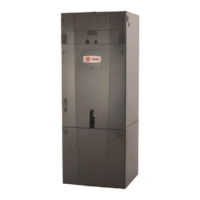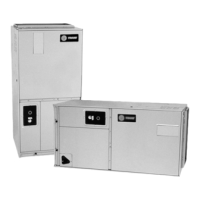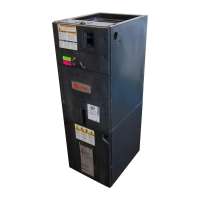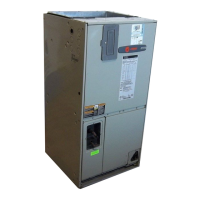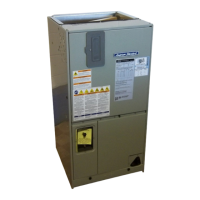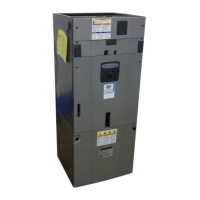BCX-SVX002A-EN
109
Water Temperature Sampling Function
The entering water temperature sampling function is used
with 2-pipe and 4-pipe changeover units and requires a
valid entering water temperature value. If the entering
water temperature value is less than 5°F (2.8°C) above a
valid zone temperature value for hydronic heating, and
greater than 5°F (2.8°C) below a valid zone temperature
value for hydronic cooling, the sampling function is
enabled. When the sampling function is enabled, the
controller opens the main hydronic valve to allow the water
temperature to stabilize. After 3 minutes, the controller
again compares the entering water temperature value to
the zone temperature value to determine if the desired
heating or cooling function can be accomplished. If the
entering water temperature value remains out of range to
accomplish the desired heating/cooling function, the
controller closes the main hydronic valve and waits 60
minutes to attempt another sampling. If the entering water
temperature value falls within the required range, it
resumes normal heating/cooling operation and disables the
sampling function.
Fan Operation
The controller supports 1-, 2-, 3-speed fans and variable-
speed fans. The fan always operates continuously while
either heating or cooling during occupied, occupied
standby, and occupied bypass operation. During
unoccupied operation, the fan cycles between OFF and
HIGH, regardless of the fan configuration. When running in
AUTO mode, the fan operates differently based on the
mode and the type of fan.
For 1-, 2-, and 3-speed fans, each time the fan is enabled,
the fan begins operation and runs on high speed for a
period of time (0.5 seconds for fan coils and 3 seconds for
fan coils) before changing to another speed. Initially
running on high speed provides adequate torque to start
the fan motor from the OFF position.
Note: In occupied mode, the controller requires continuous
fan operation because of cascade zone control. In
unoccupied mode, the fan cycles.
Manual Fan Speed Control
Regardless of the fan type, the fan runs continuously at the
desired fan speed during occupied, occupied standby, and
occupied bypass operation as follows:
• When the controller receives a communicated fan
speed signal (HIGH, MEDIUM, LOW).
• The associated fan speed switch is set to a specific fan
speed
• The Supply Fan Speed Request point is overridden
During unoccupied operation, the fan cycles between OFF
and HIGH, regardless of the communicated fan speed
signal or fan speed switch setting (unless either of these is
OFF, which in turn, will control the fan OFF).
The fan turns OFF when:
• The controller receives a communicated OFF signal
• The fan speed switch is set to OFF
• Specific diagnostics are generated
• The default fan speed is set to OFF and the fan is
operating in the AUTO mode
Note: The supply fan speed source can be configured for
BAS, local, or default value control using the
Tracer
®
TU service tool.
AUTO Fan Operation; 1-, 2-, 3-speed
Fans
When the controller receives a communicated auto signal
(or the associated fan speed switch is set to AUTO with no
communicated value present), the fan operates in the
AUTO mode. In AUTO mode, the fan operates according
to the fan default (configurable using the Tracer
®
TU
service tool). The fan speed has multiple speed
configurations (default is AUTO) or set to OFF for both
heating and cooling operation. When configured as AUTO
(and with multiple speeds available), the fan changes
based on the required capacity calculated by the control
algorithm.
AUTO Fan Operation; ECM Energy
Efficient Mode
When the controller is configured for Energy Efficient
Mode, by means of the Fan Operating Mode Request MV
point, the controller and daughter board will minimize
energy use by running the fan at the lowest possible speed
while maintaining space temperature. The controller will
fully utilize valves, economizer, or electric heat which
increases fan speed to meet space temperature (unless
the fan has been manually controlled. Refer to the
preceding section “Manual Fan Speed Control,” p. 109.
AUTO Fan Operation; ECM Acoustical
Mode
When the controller is configured for Acoustical Mode, by
means of the Fan Operating Mode Request MV point, the
controller and daughter board will minimize acoustical
nuisance by balancing changes in fan speed and total fan
noise. The controller will fully OPEN cooling and heating
valves before increasing fan speed to meet space
temperature (unless the fan has been manually controlled.
Refer to “Manual Fan Speed Control,” p. 109. If multiple
stages of electric heat exist the controller will use a single
minimum air flow for each stage.
AUTO Fan Operation; ECM Acoustical
Mode
When the controller is configured for Acoustical Mode, by
means of the Fan Operating Mode Request MV point, the
controller and daughter board will minimize acoustical
nuisance by balancing changes in fan speed and total fan
noise. The controller will fully OPEN cooling and heating
valves before increasing fan speed to meet space
Start-Up
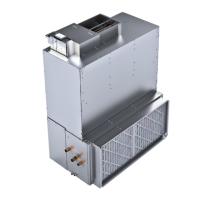
